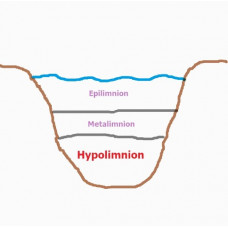A cold, oxygen-poor layer of water in a lake or other body of water that lies below a zone of rapid water temperature change (temperature jump layer). Hypolimnion is characteristic of deep lakes. Within the hypolimnion, temperature changes little and usually does not exceed 4 °С, water exchange is insignificant. They are characterized by insufficient light, which prevents photosynthesis.
A hypolimnion or under lake is a dense lower layer of water in a thermally stratified lake. The word "hypolimnion" comes from the ancient Greek: λιμνίον, Latinized: limníon, literally "lake. It is a layer that lies below the thermocline.
The hypolimnion is usually the coldest layer of the lake in summer and the warmest layer in winter. In deep temperate lakes, hypolimnion bottom water temperatures are usually close to 4° C throughout the year. Hypolimnion can be much warmer in lakes in warmer latitudes. Being at depth, it is isolated from surface wind action during the summer, and usually receives insufficient light to carry out photosynthesis.
The deepest parts of the hypolimnion have low oxygen concentrations. In eutrophic lakes, the hypolimnion is often oxygen-free. The deep mixing of the lakes in the fall and early winter allows oxygen to be transported from the epilimnion to the hypolimnion. Cooling of the epilimnion during fall reduces lake stratification and allows mixing to occur. The hypolimnion can be oxygen-free for up to six months. Anoxia is more common in the hypolimnion in the summer, when mixing does not occur. In the absence of oxygen from the epilimnion, decomposition can cause hypoxia in the hypolimnion.
Hypolimnion
Tags: hypolimnion

